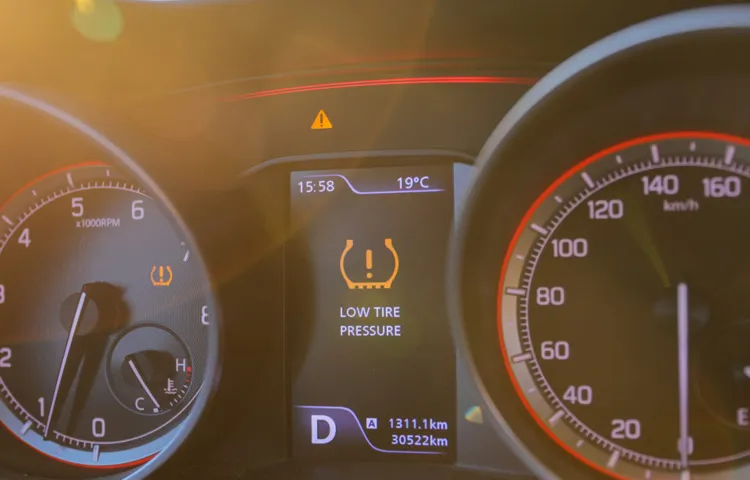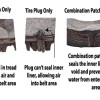Are you tired of dealing with the dreaded tire pressure sensor light? It’s frustrating, isn’t it? Thankfully, fixing a tire pressure sensor is easier than you might think. With some basic knowledge and a little elbow grease, you can get that pesky light to turn off and avoid a potential blowout on the road. In this step-by-step guide, we’ll walk you through the process of fixing a tire pressure sensor.
Whether you’re a seasoned DIY mechanic or a novice, you’ll find everything you need to know right here. We’ll cover the tools you’ll need, how to locate the faulty sensor, and how to replace it yourself. Think of it as changing a light bulb – a little effort goes a long way.
But unlike a light bulb, a tire pressure sensor can have serious consequences if it’s not functioning properly. That’s why it’s important to take care of it as soon as possible. Don’t let the tire pressure sensor light bring you down.
With our guide, you’ll be able to fix it in no time. So let’s roll up our sleeves and get started!
Table of Contents
Introduction
If you’re wondering how to fix a tire pressure sensor, it’s important to first understand the purpose of the sensor. It’s responsible for monitoring the air pressure in your tires and letting you know if levels are too low. This helps prevent blowouts and ultimately keeps you safe on the road.
If your sensor is malfunctioning, you may notice a warning light on your dashboard indicating an issue. Fortunately, fixing the problem is often as simple as replacing the battery in the sensor or resetting it. However, in some cases, the issue may be more complex and require professional attention.
Either way, it’s important to address the issue promptly to ensure your vehicle is functioning safely and efficiently.
Explanation of a Tire Pressure Sensor and its Importance
Tire pressure sensors have become a crucial component in modern vehicles, providing real-time feedback to drivers about the status of their tires. Without this technology, drivers might not realize there’s a problem with their tires until something has gone seriously wrong, such as a flat tire or a blowout. By monitoring tire pressure levels and alerting drivers when something is amiss, these sensors help keep drivers and passengers safe on the road.
In fact, keeping your tires properly inflated can improve fuel efficiency, extend tire life, and reduce the risk of accidents. So, it’s essential to make sure your tire pressure sensors are functioning correctly and that you’re keeping your tires inflated to the recommended level.
Symptoms of a Faulty Tire Pressure Sensor
If you’re experiencing issues with your tire pressure sensor, it’s important to address them promptly, as driving with an inaccurate reading can lead to safety hazards. Some common symptoms of a faulty tire pressure sensor include an illuminated dashboard light warning of low tire pressure, uneven tire wear, and reduced gas mileage. To fix the sensor, you may need to replace it entirely, as failed sensors cannot be repaired.
First, make sure to check your tire pressure manually with a gauge to confirm that the sensor reading is incorrect. Once you’ve determined that the sensor is faulty, you can purchase a replacement at your local auto parts store or mechanic. Installing a new sensor can sometimes require specialized tools and knowledge, so it may be best to have a professional mechanic handle the job.
In the long run, addressing tire pressure sensor issues can improve the safety and efficiency of your vehicle.
Diminished Performance and Inaccurate Readings
If you notice your car’s fuel efficiency declining suddenly or not getting accurate tire pressure readings, there may be an issue with your tire pressure sensor. A faulty sensor could also lead to your vehicle’s handling and braking performance being affected. You may notice an unusual noise or vibration coming from your wheels when you drive or find it harder to steer the vehicle.
This is because a damaged sensor cannot accurately monitor tire pressure and transmit readings to your car’s computer. So, it’s essential to have your vehicle checked by a professional mechanic if you experience any of these problems. Don’t ignore the signs as they can lead to safety risks and costly repairs down the road.
Always ensure your tire pressure sensors are working correctly to drive safely.
Emergence of Warning Signs and Notifications
If you own a modern car, your tire pressure monitoring system (TPMS) will alert you if the pressure in your tires is low. TPMS is a valuable safety feature that helps prevent accidents caused by under-inflation. Despite its importance, the tire pressure sensor can sometimes be faulty, which can lead to incorrect readings and, therefore, warning signs and notifications.
Suppose your TPMS alerts you of low tire pressure even though your tires are fine or vice versa. In that case, the sensor may have malfunctioned, and you will need to have it checked by a professional technician. Additionally, other symptoms of a faulty tire pressure sensor include a TPMS warning light that stays on, erratic readings of tire pressure, and warning alerts that come on when you start your car.
By being aware of these warning signs, you can take swift action to ensure that your car remains safe for you and other drivers on the road. Remember, properly inflated tires are critical for safe driving, so have your tire pressure sensor inspected regularly.
Reasons for Malfunctioning Tire Pressure Sensors
Tire pressure sensors are an essential part of modern car safety features, and malfunctions can cause problems for drivers. The most common reason for a malfunctioning tire pressure sensor is a dead battery, which is easy to fix by simply replacing the battery. Another reason for a malfunctioning sensor is a damaged valve stem, which can cause air to leak from the tire.
This problem can be fixed by replacing the valve stem or repairing any damage to the tire. Sometimes the sensor itself can be damaged, in which case it will need to be replaced. Software and connectivity issues can also cause problems with tire pressure sensors, and resetting the system or updating the software may fix the problem.
It’s important to address any issues with tire pressure sensors promptly, as driving with underinflated tires can affect the handling of the vehicle and lead to unsafe driving conditions. With a little troubleshooting, most problems with tire pressure sensors can be easily fixed, ensuring a safer and smoother driving experience.
Battery Exhaustion
Battery exhaustion is one of the most common reasons for malfunctioning tire pressure sensors. These sensors are designed to alert drivers when the tire pressure is too low or too high. However, if the battery in the sensor dies or is running low, it won’t be able to send out a signal.
When this happens, the tire pressure warning light will illuminate on your dashboard, indicating that there is a problem. To solve this issue, you’ll need to replace the battery in the sensor. This is a relatively easy task that can be done by most car owners.
In some cases, the battery may also need to be reprogrammed to ensure that it is communicating properly with your vehicle. If you’re not comfortable performing this task yourself, you can have a mechanic or tire service technician handle it for you. By taking care to ensure that your tire pressure sensors are properly functioning, you’ll be helping to ensure your safety on the road.
Corrosion and Accidental Damage
Corrosion and accidental damage are two of the most common reasons for malfunctioning tire pressure sensors. Corrosion can occur when moisture seeps into the sensor’s wiring or other components, causing rust or other types of damage. This can affect the sensor’s ability to accurately measure tire pressure, leading to false alarms or no warnings at all.
On the other hand, accidents can also cause damage to the sensor, such as impacts from road debris or hitting a curb too hard. When this happens, the sensor’s delicate components can become damaged or displaced, causing the sensor to malfunction or stop working altogether. It’s important to keep an eye on your tire pressure sensors and seek professional help if you suspect any issues.
Regular maintenance and inspections can help prevent these problems from occurring and keep your tires in good condition, ensuring a smooth and safe driving experience.
Steps to Fix a Tire Pressure Sensor
If you’ve ever noticed your tire pressure warning light pop up on your dashboard, it might be due to a malfunctioning tire pressure sensor. This sensor is responsible for communicating the air pressure in each tire to your car’s computer, allowing you to stay informed about any changes in pressure. Fortunately, there are steps you can take to fix a tire pressure sensor.
First, check the air pressure in each tire and refill them as needed. If the sensor still isn’t working, you may need to reset it using your car’s onboard computer or contact a mechanic for further inspection. In some cases, the sensor itself may need to be replaced.
Whatever the cause, fixing a tire pressure sensor is crucial for staying safe on the road and avoiding any unexpected blowouts or flat tires. So, don’t hesitate to take action if you suspect there’s an issue. With a little effort, you can get your sensor back up and running again in no time.
Step 1: Locate the Malfunctioning Tire Pressure Sensor
If you’re experiencing issues with your vehicle’s tire pressure sensor, the first step is to locate the damaged sensor. This may require the use of a diagnostic tool or simply a visual inspection, depending on the make and model of your vehicle. Once you’ve located the malfunctioning sensor, you’ll need to assess the severity of the damage and determine if it can be repaired or if it needs to be replaced entirely.
In some cases, a simple reset or recalibration may solve the problem, while in others, a full replacement is necessary. It’s important to address tire pressure sensor issues promptly to ensure optimal vehicle performance and safety. By taking the time to properly diagnose and repair or replace a malfunctioning sensor, you can avoid more serious issues down the line and ensure your vehicle remains in good working condition.
Step 2: Inspect the Sensor for Physical Damage and Corrosion
When attempting to fix a tire pressure sensor, the second step is to inspect the sensor for physical damage and corrosion. This is an important step to take because if there is any sort of damage or corrosion, it can prevent the sensor from working properly. You can begin by closely examining the sensor for any signs of physical damage, such as cracks, dents, or leaks.
If there is any visible damage, it is likely that the sensor needs to be replaced. Additionally, corrosion can also cause problems with the sensor’s functionality. Check for any signs of rust or other types of corrosion on the sensor.
If there is significant corrosion present, it may be necessary to replace the sensor or to clean it thoroughly. By inspecting the sensor for physical damage and corrosion, you can determine whether it is necessary to replace the sensor or if it can be fixed through other methods.
Step 3: Interpret and Reset Sensor Notifications
After identifying and diagnosing the issue with your tire pressure sensor, the next step to resolving the problem is to interpret and reset the sensor notifications. This can be done by using a specialized tool or software that is designed for your specific vehicle. The tool will display a code or message that indicates the exact issue with the sensor, making it easier to fix the problem.
Once you have interpreted the notification, the next step is to reset the sensor. This can usually be done by following a simple procedure outlined in the owner’s manual. It’s important to note that resetting the sensor doesn’t fix the underlying problem, so if the issue persists, it may be necessary to replace the sensor.
By taking these steps, you can ensure that your tire pressure sensors are working correctly and that your vehicle is operating safely on the road.
Step 4: Replace the Battery or the Entire Sensor
If none of the previous steps have fixed your tire pressure sensor, it may be time to replace either the battery or the entire sensor altogether. First, check the user manual to see whether the battery is replaceable. If so, purchase a replacement battery and follow the instructions in the manual to replace it.
If the battery is not replaceable, or if replacing it does not fix the issue, it may be time to replace the entire sensor. This can be done by a professional mechanic or at a tire shop. Keep in mind that the cost of replacing the sensor may vary depending on the make and model of your vehicle.
Ultimately, replacing the battery or the entire sensor is a step that should not be skipped if the sensor is still malfunctioning after attempting other fixes.
Step 5: Test the Functionality of the Sensor
After replacing the battery and conducting a relearn procedure, the next step to fixing a tire pressure sensor is to test its functionality. One of the simplest ways to do this is by checking if the sensor is transmitting data to the vehicle’s system. This can be done by using a diagnostic tool to scan the sensor and see if it’s sending the correct readings to the system.
Another test involves taking the vehicle for a ride to see if the tire pressure readings change according to the sensor’s signals. It’s also essential to check if the vehicle’s warning light goes off after the tests are completed. If the sensor still fails to function correctly, it may be necessary to replace it entirely.
By carrying out these tests, you can ensure that the tire pressure sensor is in good working condition, which can help prevent potential accidents caused by underinflated tires.
Conclusion
In conclusion, fixing a tire pressure sensor is like solving a puzzle – it requires patience, attention to detail, and a bit of trial and error. However, with the right tools and knowledge, anyone can become a DIY tire sensor repair person. So, don’t let a pesky tire pressure light ruin your day.
Grab your tire gauge, inflate those tires, and get back on the road with confidence!”
Importance of Regular Maintenance and Inspection
Regular maintenance and inspection are crucial for any vehicle to maintain optimal performance and safety. One of the key components that require regular attention is the tire pressure sensor. This tiny sensor provides essential information about the state of the tires, ensuring safe driving and fuel efficiency.
If you notice any issues with your tire pressure or warning lights illuminating on your dashboard, it’s crucial to take immediate action. Here are some steps you can take to fix a tire pressure sensor issue. First, check if the sensor requires a replacement battery, which is often the cause of malfunction.
Next, make sure the sensor isn’t dirty or contaminated with debris, which can cause false readings. Finally, reset the sensor by following the user manual’s instructions or engaging a professional mechanic. Remember, a small issue with the tire pressure can lead to significant safety hazards, such as tire blowouts, so it’s important to keep your sensors in optimal condition.
Final Thoughts
Fix a Tire Pressure Sensor Final Thoughts: Fixing a tire pressure sensor is not an easy task, but it’s not impossible either. As with any car maintenance task, ensure that you have the right tools and equipment before beginning the process. Remember, a faulty tire pressure sensor can have a significant impact on your vehicle’s safety.
Therefore, it is essential to fix it promptly. Check your car manual or speak with a qualified mechanic for further advice. Remember, regular inspection and maintenance of your car’s tire pressure sensor will help to keep you and your passengers safe while driving on the road.
So, don’t delay, take the necessary steps to fix your tire pressure sensor today!
FAQs
What causes a tire pressure sensor to malfunction?
A tire pressure sensor may malfunction due to a dead battery, physical damage, or a malfunctioning valve stem.
How do I know if my tire pressure sensor is malfunctioning?
If your tire pressure sensor is malfunctioning, you may see a warning light on your dashboard, or you may notice that your tire pressure readings are inaccurate.
Can I drive with a malfunctioning tire pressure sensor?
Yes, you can drive with a malfunctioning tire pressure sensor, but it is not recommended as you may not know if your tire pressure is low or high, which can lead to unsafe driving conditions.
How much does it cost to replace a tire pressure sensor?
The cost of replacing a tire pressure sensor can vary depending on the make and model of your vehicle and the location of the sensor, but it typically ranges from $50 to $250.
Can I replace a tire pressure sensor myself?
It is possible to replace a tire pressure sensor yourself, but it can be a complex process that requires specialized tools and equipment. It is recommended to have the sensor replaced by a professional mechanic.
How often should I check my tire pressure sensor?
It is recommended to check your tire pressure and tire pressure sensor at least once a month or before embarking on a long road trip.
What should I do if my tire pressure sensor keeps malfunctioning after replacement?
If your tire pressure sensor keeps malfunctioning after replacement, you may need to have it reprogrammed or inspected for any underlying issues. It is recommended to consult a professional mechanic for assistance.



